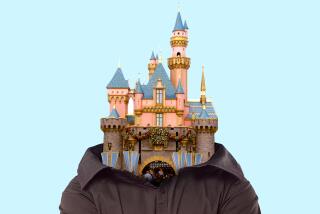A royal gain
Where once they stood alone, now they are united, their faces smiling up from T-shirts and backpacks in small groups like particularly well-coifed members of the Justice League. They host teas and birthday parties, hold classes in animal husbandry and geography, have their own color scheme including a signature paint available at Home Depot. Their influence over fashion is incalculable -- their clothing and accessories coveted by and reproduced for millions of fans. They are about to launch their own line of personal care products.
They are the Disney Princesses and their goal is world domination.
In 2004, 23 years since the publication of “The Cinderella Complex: Women’s Hidden Fear of Independence,” princess culture is entering what can only be considered its Golden Age. In the three years since Disney executives decided to consolidate Cinderella, Snow White, Sleeping Beauty, Ariel (“The Little Mermaid”), Belle (“Beauty and the Beast”) and Jasmine (“Aladdin”) into one brand, princess merchandise sales have skyrocketed from $200 million in 2000 to $2 billion last year.
In Los Angeles, Disney Princess teas held in conjunction with the release of “Princess Diaries 2” on Wednesday at the El Capitan Theater sold out their Saturday and Sunday spots weeks before the movie premiered. Those teas and other princess-themed events have become popular permanent additions to Walt Disney World attractions. In Japan, princess classes, which began in Tokyo three years ago as an attempt to introduce the new princess brand, have spread to five cities -- last year, more than 15,000 girls paid $150 a pop to learn from Snow White how to love animals or from Ariel how to sing.
And princesses don’t just rule the Disney kingdom. As the media serves up stories of middle- and upper-class mothers bowing out of the workplace in search of new family values, females of every age now sport crowns and tiaras and T-shirts proclaiming their temperamental if not dynastic claim to the word. Princess costumes and accouterment remain top sellers at toy stores everywhere. Barbie and her many full-size accessories are available in fairy tale and international princess form. Recent movies like “Ella Enchanted,” “The Prince & Me,” “A Cinderella Story” and now “Princess Diaries 2” have hauled out all the time-honored symbols of the mythology -- the jewels, the dresses, the handsome boyfriend and, of course, all that dancing.
The films, like the books many are based on, all have slight post-feminist twists, but they still adhere to the basic princess ethos: You may think for the moment that you are a normal, powerless girl plagued by mean friends and nagging parents/stepparents, but really you are a princess, with liberation and a truly excellent wardrobe just a few plot points away.
“Whether feminists like it or not,” says Gary Foster, spokesman for Disney consumer products, “at some point in their lives, most girls want to be a princess.”
“The princess brand is all about fantasy,” adds Mary Beech, director of franchise management for Disney Princess. “It’s transformational and allows the girls to be in charge, and in real life, children aren’t in charge of very much.”
Power of the princess
Foster and Beech may have a bit of a bias, but they are merely echoing the sentiments of psychologist Bruno Bettelheim in his groundbreaking 1985 book, “The Uses of Enchantment.” “Every child at some time wishes that he were a prince or a princess,” he wrote, “and at times, in his unconscious, the child believes he is one, only temporarily degraded by circumstances.”
Contemporary fairy tale experts concur. “The princess myth is very tempting,” says Maria Tatar, dean of humanities at Harvard University and author of “The Annotated Classic Fairy Tales” and “The Annotated Brothers Grimm.” “You start out as disempowered and by becoming royalty you don’t have to do the work, you get everything you want.”
Wish-fulfillment story lines fuel many of the books and films aimed at tween and teen girls, which gives princess culture the staying power it needs to transcend the fairy tale reading years. In the preadolescent and adolescent years, many girls are beset by self-doubt, and they look to transformative narratives to give them hope and confidence.
The “rags-to-riches story is everywhere these days,” says Rachel Simmons, author of “Odd Girl Out: The Hidden Culture of Aggression in Girls.” “All the teen and tween movies are about girls who go from being unloved and uncool to being incredibly popular. Which is what happens to princesses.”
Simmons, who works with the Empower Project, a Washington, D.C., group devoted to improving the lives of girls, says she has been surprised by the number of princess T-shirts and paraphernalia she has seen on the streets of New York and wonders if it isn’t a response to the tough skate-board girl mentality that has also fueled fashion and attitudes among teens. “The princess is the last frontier of acceptable girliness,” she says. “She applauds any arena that allows girls to access playfulness and protects them from sexualizing themselves before they are ready. “It points to how crazy our times have become that I, as a feminist, am promoting princess culture because, hey, at least you don’t have a 12-year-old wearing a thong.”
For 6-year-old Georgia Freeman, the clothes trump the prince every time. Erika Schickel, Georgia’s mother, sees her daughter’s obsession with all things princess as much more of a fashion statement than a narrative leaning. “For her, it’s all about the silky, swishy dresses,” says Schickel, a writer who lives in Los Angeles. She is perplexed about how her second daughter became so princess-centric. “I am certainly not a princess type. Maybe that’s it. Maybe they see all the moms working so hard and want a happily-ever-after in a castle. Maybe that’s why moms buy into it too.”
Rae Dubow, a Los Angeles drama teacher, tried to show her 5-year-old daughter the other side of the fairy tale myth by reading her “Cinder Edna,” a retelling of the famous tale by Cinderella’s sensibly shod, eco-friendly neighbor. Cinderella, by contrast, is made to seem vain and silly. “My daughter was not at all interested in Edna,” says Dubow. “All she wanted to know was why Cinderella didn’t have a bigger part because she is so pretty.”
Schickel has mixed feelings about her role in providing the items necessary for a modern princess. “As a feminist, I think, ‘Of course they’re obsessed with princesses because princesses are being crammed down their throat and not just from Disney, but from all these tweener movies.’ But then I remember as a little girl just craving really pretty things too.”
Fairy tales sell
Certainly at Disney, it was all about selling pretty things. In 1999, when former Nike executive Andy Mooney joined the company as chairman of consumer products, he was faced with flat-lining Mickey and Pooh brands. When he challenged his staff to come up with the next big thing, “Think pink” was the unanimous answer. According to Foster, a colleague took Mooney to Disney on Ice, which featured several of the princesses. The audience was full of little girls in full princess get-up; Mooney saw the future, and it involved a lot of tulle.Soon enough, test marketing was being done in Disney stores on signature pink and purple merchandise featuring the six core princesses. (In some items, Pocahontas and Mulan are included; although they are not technically princesses, Beech explains, their stories hit most of the necessary transformative notes.) The results were so successful the merchandise moved into wider markets, from Toys R Us to Target, and there were murmurings of a face-off between the princesses and Barbie, still the No. 1 girl franchise. Barbie, of course, has several princess lines; next month, Mattel will debut a Barbie Princess and Pauper computer game.
“It’s a lifestyle rather than a toy line,” says Beech of the Disney Princess brand, which now can be found on items including bandages, toothbrushes and umbrellas.
In about the last year, Disney has also attempted to brand the male characters as Disney Heroes, but, according to Foster, until recent purchases landed them the Power Rangers franchise, the company has had little success with boys.
That’s because Bettelheim was wrong on one count, says Tatar: Boys, do not want to be princes. “Prince Charming is a female fantasy,” she says. “No boy wants to be Prince Charming. Boys want to be superheroes.”
The difference, she says, is the relationship to the family. A princess, no matter how powerful she becomes, remains within the domestic sphere. “She is beautiful, magnetic, charming and magical,” Tatar says. “But while boys want to be out of the family, having adventures, the princess remains part of a family, defined by love and marriage.”
This is the part of princess culture that rubs some women, and men, the wrong way -- even writer Dave Barry has been moved to write several columns protesting his young daughter’s princess fixation, reminding her that no one on any color horse was getting anywhere near her until she was 47.
Although Cinderella remains the most popular princess, her cheerful acceptance of enforced drudgery seems at best a bit retro. The recent crop of princess-themed films, starting perhaps with Drew Barrymore’s prince-carrying Cinderella in “Ever After,” are modern retellings, with feisty, independent characters -- Hilary Duff’s character in “A Cinderella Story “ is as infatuated with her dream of going to Princeton (get it?) as she is with the incredibly handsome guy she meets via a chat room. But in the end, the prize is always the prince, rather than the kingdom.But according to some mothers, princess play rarely includes a prince. Instead, it remains a very girl-centric universe, sort of like a Saturday morning version of “Sex and the City.”
It’s the clothes and the castle and the tiara,” says Schickel, who has never heard her daughters or their friends even mention a prince. “Princes are just another accessory,” Disney’s Beech says. “And they’re not as important as the dress or the crown.”
More to Read
Inside the business of entertainment
The Wide Shot brings you news, analysis and insights on everything from streaming wars to production — and what it all means for the future.
You may occasionally receive promotional content from the Los Angeles Times.











